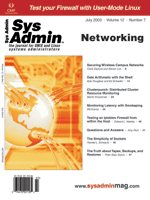 syslog syslog
Æleen Frisch, author of Essential System Administration
wrote an excellent series of articles for the O'Reilly &
Associates Web site last year describing a few of her favorite tools.
In the series, she explores her "current list of the most useful
and widely applicable open source administrative tools." She
says, "In general, these tools can make your job easier no
matter what Unix operating system your computers run." On the
list are the Amanda backup utility, LDAP, GRUB, and the Nagios monitoring
package. Because this issue of Sys Admin features the topic
of networking, I'll share a few quick facts about Nagios here.
Nagios, written by Ethan Galstad, was formerly known as Netsaint.
The Nagios home page (http://www.nagios.org) states:
Nagios® is a host and service monitor designed to inform you
of network problems before your clients, end-users or managers do.
It has been designed to run under the Linux operating system, but
works fine under most *NIX variants as well. The monitoring daemon
runs intermittent checks on hosts and services you specify using
external "plug-ins" which return status information to
Nagios. When problems are encountered, the daemon can send notifications
out to administrative contacts in a variety of different ways (email,
instant message, SMS, etc.). Current status information, historical
logs, and reports can all be accessed via a web browser.
Æleen Frisch's article, which can be found here:
http://www.onlamp.com/pub/a/onlamp/2002/12/05/essentialsysadmin.html
takes an in-depth look at Nagios and provides screenshots and annotated
configuration files detailing key points. Frisch says that configuring
Nagios can seem daunting and involves a fair amount of startup overhead.
She also says, however, that the configuration process is not as hard
or time-consuming as it initially seems and that it's well worth
the effort. Note that Netsaint configuration files are also compatible
with Nagios or can be converted with the utility provided. Frisch
writes:
Nagios monitors a wide variety of system properties, including
system-performance metrics such as load average and free disk space;
the presence of important services like HTTP and SMTP; and per-host
network availability and reachability. It also allows the system
administrator to define what constitutes a significant event on
each host...
It is also possible to define an event handler: a program that
is run when a problem is detected. Such programs can attempt to
solve the problem encountered, and they can also proactively prevent
some serious problems when they get triggered by warning conditions.
The information that Nagios collects is displayed in a series of
automatically generated Web pages. This format is quite convenient
in that it allows a system administrator to view network status
information from various points throughout the network.
See the Nagios home page for downloads and refer to Frisch's
article and the Nagios documentation for more details.
Sincerely yours,
Amber Ankerholz
Editor in Chief
| 
